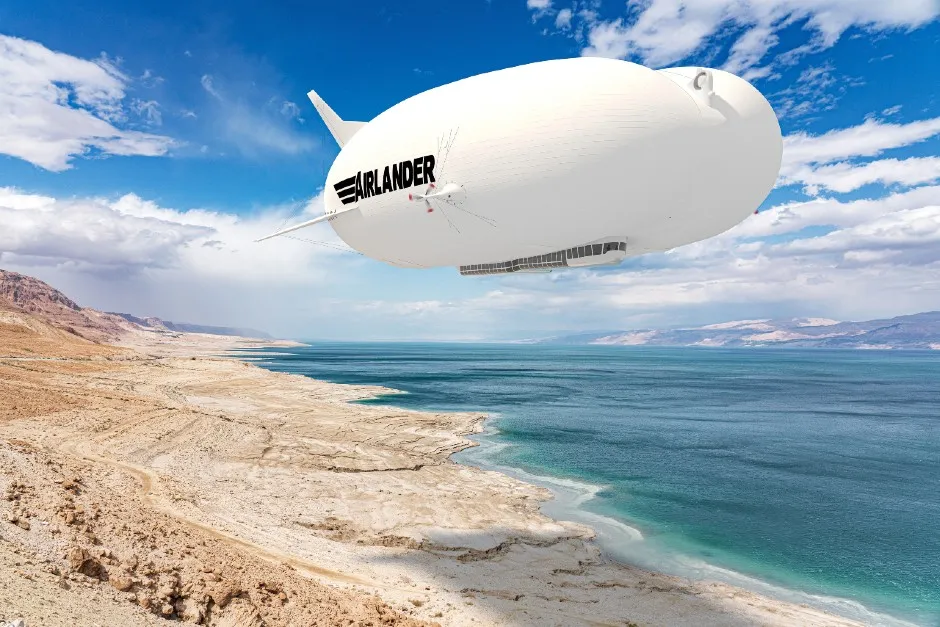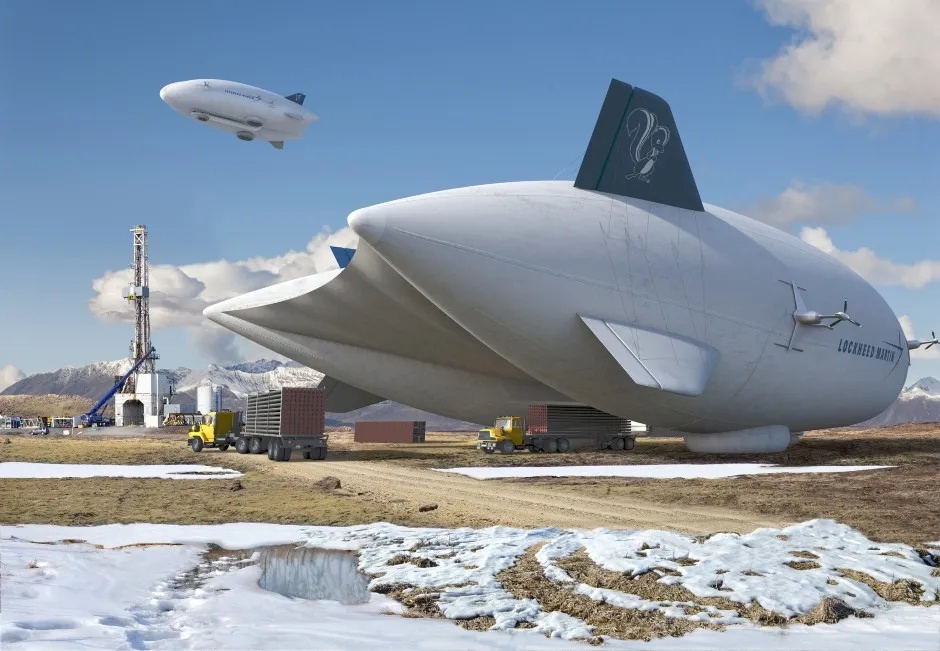What if you could fly with a fraction of the carbon emissions of a conventional aeroplane? What if you could cruise through the clouds with almost zero noise? And, what if you could board your aircraft without first having to navigate a sprawling airport and all its associated infrastructure?
That’s the elevator pitch for a new generation of airships, the retro-futuristic, blimp-style vehicles that might just revolutionise air travel in the coming decade. Dotted around the world, companies from small start-ups to aerospace giant Lockheed Martin are building lighter-than-air, modern-day Zeppelins with a broad range of applications in mind.
One British company, Hybrid Air Vehicles (HAV), recently laid out plans for a series of short-haul flights that would enable city-hopping trips aboard its Airlander 10 craft. Proposed routes include Liverpool to Belfast, Oslo to Stockholm and Barcelona to Palma. And per passenger, HAV claims the carbon footprint of such a flight would be less than a tenth of the same journey in a conventional jet plane, because helium is used as a lifting gas to get the craft airborne.
"Three quarters of the carbon reduction almost comes for free," says Mike Durham, HAV’s chief technical officer. "It’s helium keeping us up so we only need fuel [from four combustion engines] to push us along. Conventional aeroplanes need to burn fuel to stay up as well."

Of course, without a jet engine, airships are considerably slower than modern planes. HAV says its proposed Liverpool-to-Belfast route would take 5 hours and 20 minutes (although a similar journey by ferry would take more than nine hours).
As the world slows down in response to COVID-19 and as we grapple with how to reduce carbon emissions from air travel and freight, airships may offer viable alternatives – and not just in passenger flights.Hybrid airships are touted for aid drops, search and rescue, eye-in-the-sky command centres and tourism. Imagine a bird's eye tour of the North Pole or Great Barrier Reef. Some believe luxury airships could even become playthings of the super-rich, decadent floating mansions that offer the same status as a luxury yacht.
The most practical application, however, lies in freight.
"I’ve long believed that hybrid airships would be best placed to disrupt global shipping given their volumetric capacity, the increasing desire for rapid delivery of goods from overseas, and the fact that their speed and operating cost would enable faster delivery than by ship with a proportionally lower increase in transportation cost," says John-Paul Clarke, professor of aerospace engineering at the University of Texas at Austin.

International shipping doesn't have to be fast, so transporting food or chemicals by airship could save significant carbon emissions compared to large freight vessels at sea. Yet for all their green credentials, some argue that helium-powered airships are not the future of green transport.
"The main source of helium production is oil and gas extraction," says Julian Hunt, a researcher at the International Institute for Applied Systems Analysis in Austria. "If the main driver for a future airship industry is to reduce aviation CO2 emissions, a helium-based airship industry will have to rely on a functioning oil and gas industry. It does not make sense."
Hunt has proposed using the jet stream to propel airships at far greater altitudes than something like the Airlander plans to fly.
But if helium – which is also a non-renewable resource – isn’t the answer, then it raises two alternative H-words, both with rather negative connotations: hydrogen and Hindenburg. In 1937, the most infamous airship that ever flew exploded midair and crashed in front of photographers and filmmakers, killing 36 people. Powered by (flammable) hydrogen, the crash was a PR disaster that contributed to the demise of airships as a popular mode of transport.
That was over 80 years ago, however. Most in the industry believe hydrogen's comeback is inevitable.
"Hydrogen is the obvious alternative to helium," says Clarke. "It can be produced greenly and more and more cheaply with each passing day. It has an unfortunate reputation due to past accidents [but] we have learned a lot over the years about how to handle hydrogen, especially in transportation settings, and it is now being used to propel cars, trucks, and aircraft."

So what's it like to fly in an airship? According to Durham, a trip on HAV's Airlander would be a lot smoother than modern flight.
"It’s a low-noise, low-vibration, low-turbulence cabin space where in many operations you may even be able to open a window. It’s also got floor to ceiling windows, so the ambient light is different as well. The cabin has a lot more volume per passenger."
Clarke and Hunt both doubt that airships offer a viable alternative to short-haul flights, citing issues like wind variability and logistical issues, but Durham remains optimistic.
"There will be sweet spots that work for our product and there will be spaces that won’t work. It’s probably not going to work for long-haul flights," he says.
"I think they have a place to play in society moving forward. The human race is going to have to come to terms with the fact that we cannot spend our time rushing and tearing about the place, ignoring the planet. Lighter-than-air travel has a part to play to support that drive to become greener."
Airship designs ready for takeoff
Lockheed Martin
Skunk Works is an arm of the aerospace giant whose purpose is to develop new kinds of aircraft. The department has developed a demonstrator airship that it believes is ready for commercial deployment delivering aid in disaster zones or minerals from remote mining sites. It has also developed a robot that crawls across the exterior of the blimp seeking and repairing tiny holes.
Flying Whales
This French manufacturer is developing an airship designed for freight that picks up and drops off its payload without actually landing. Using helium to hover above the ground, it will have winches that lift or lower its payload, saving energy. The vehicle is designed to carry up to 66 tons.
Atlas LTA
This Israeli start-up is hoping to join a growing airship market with three different designs. Primarily built for transporting freight, the ships have cargo bays built into the airship and, unlike a lot of current designs, would be powered by hydrogen fuel cells, supplemented by diesel.
Read more about the future of flight:
